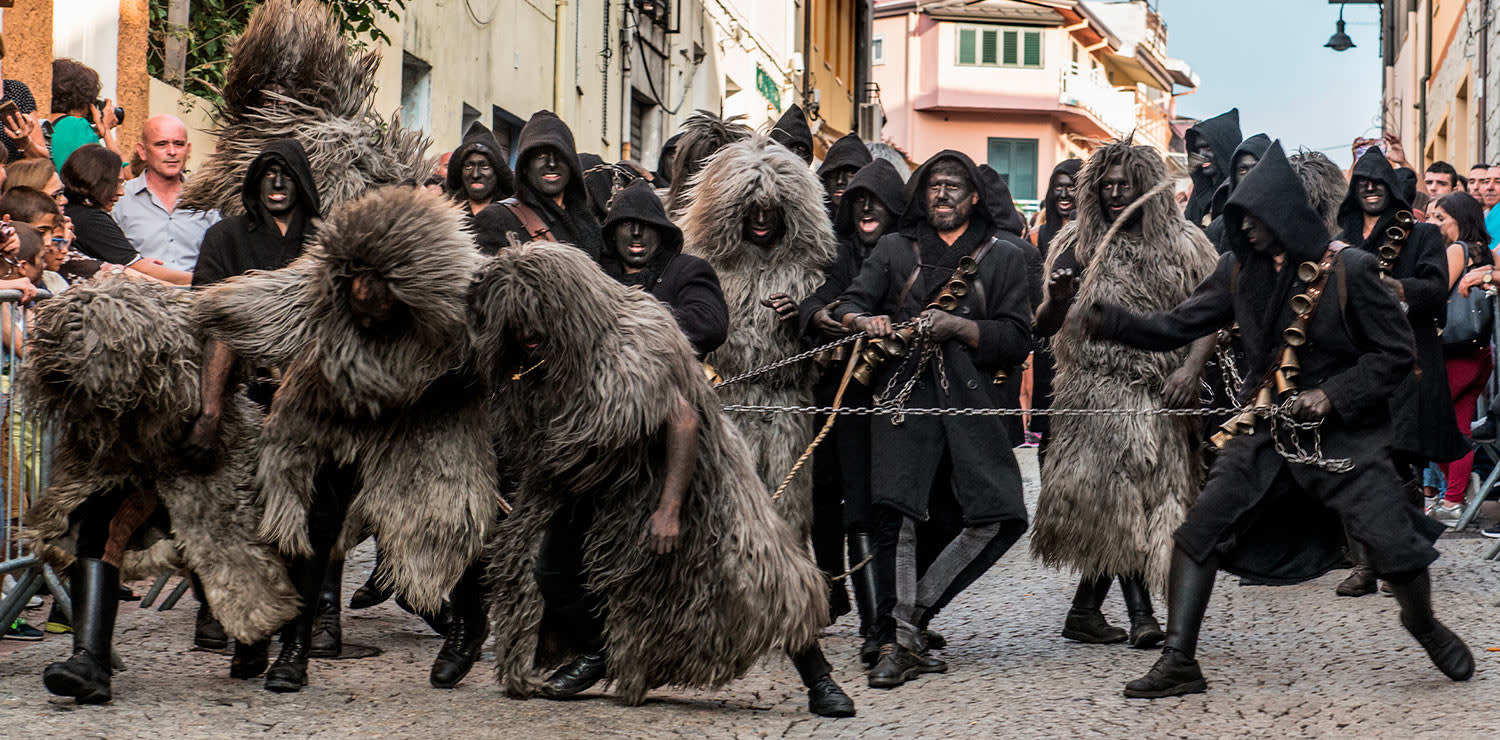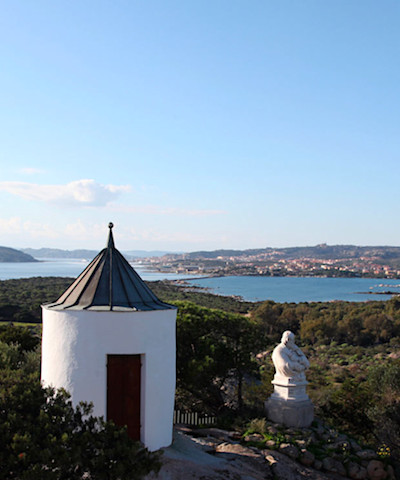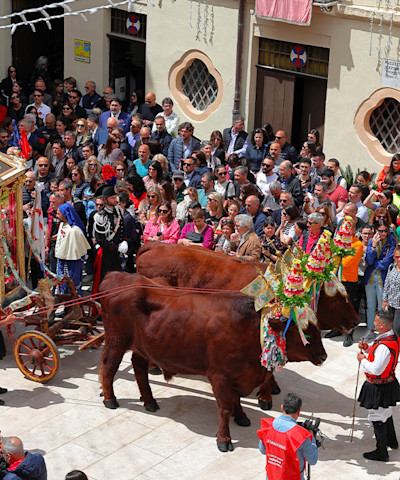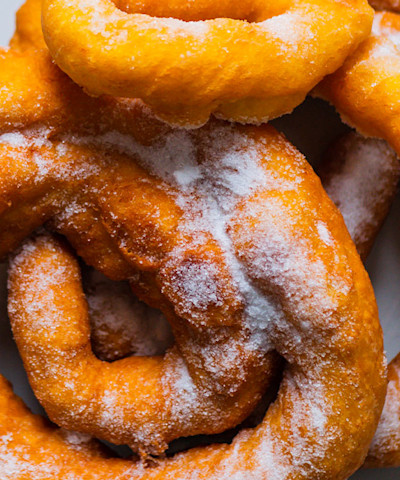Traditional Carnival masks in Sardinia
What are the most famous Sardinian masks and what they represent
Carnival in Sardinia is a unique experience, a deep immersion in ancestral rituals and symbolism rooted in ancient times. The island, rich in traditions and legends, celebrates this festivity with masks and rituals that tell the story and identity of its communities.
Let us discover together some of the most iconic masks that make the Sardinian Carnival an unforgettable event. If, on the other hand, you would like to discover the most beautiful Carnival celebrations in Sardinia, click here!
Mamuthones e Issohadores of Mamoiada
One of the best known and most evocative representations of Sardinian Carnival is that of the Mamuthones and Issohadores of Mamoiada. The Mamuthones wear wooden masks painted black, sheep skins and, above all, heavy cowbells on their backs that they shake to the rhythm of a tribal dance. Their steps are cadenced, almost hypnotic, and create a collective choreography of great visual and aural impact. They represent, perhaps, bestiality, primordial instinct, wild nature to be tamed. The Issohadores, on the other hand, embody the element of control and order. They derive their name from the rope, called sa soha or sa soca, which they use as a sort of lazzo to symbolically ‘catch’ women and men in the crowd. This gesture, performed with grace and dexterity, is seen as a wish for good luck and fertility for the agricultural year. Their bright clothes, often red and white, and agile movements contrast with the gravity and gloom of the Mamuthones, creating a balance between opposing forces.
Boes e Merdules of Ottana
At Ottana, Carnival takes on an evocative character thanks to the Boes and Merdules, masks that tell of the complex relationship between man and animal. The Boes, with their masks depicting cattle, represent the primordial force of wild nature. Their masks are often decorated with motifs reminiscent of the horns and distinctive features of cattle, a symbol of power and endurance. Their movements are sometimes violent, as if to recall the rebellion of untamed nature. The Merdules, on the other hand, wear masks with distorted, almost grotesque human features, emphasising the shepherd's toil, sacrifice and tenacity. These figures impersonate the man who tries to tame and control the force of nature represented by the Boes, in a kind of symbolic dance that reproduces the everyday life of the agro-pastoral world. The cadenced rhythm of the cowbells, the sound of rubbing skins and guttural cries contribute to creating an atmosphere full of mystery and meaning.
Su componidori
Among the traditional Sardinian masks, Su Componidori stands out for its elegance and enigmatic charm. With his androgynous features and delicate features, he stands out clearly from the masks of the Barbagia and Ogliastra Carnival, which are often dark and savage. Su Componidori is the absolute protagonist of the Sartiglia di Oristano. This figure is considered almost a demigod, a symbol of protection and guidance during the event. His clothing is rich in symbolism: he wears a terracotta mask with refined features, which gives him an aura of mystery and sacredness. He wears leather shoes, a flawless white shirt and a white veil covering his head, complemented by an elegant black top hat. Su Componidori not only embodies ritual authority, but also represents the union of the human and the divine, tradition and spectacle. His role during the Sartiglia is charged with responsibility, and his every gesture is imbued with meaning.
Sos Thurpos di Orotelli
The masks of Sos Thurpos are one of the most fascinating elements of the Carnival of Orotelli, a small town in Barbagia that proudly preserves its traditions. The rediscovery of these masks is due to ethnologist Raffaello Marchi, who undertook extensive research in 1978, bringing to light another piece of history linked to the Barbagia Carnival. The Sos Thurpos, whose name means ‘blind’ in the Sardinian language, are austere and mysterious figures, symbols of sacrifice and resilience in the rural world. Their distinctive feature is their faces blackened by burnt cork ash, applied during the ritual of dressing. They wear a long orbace coat called su gabbanu, whose hood covers part of their face, making them even more enigmatic. In addition to su gabbanu, the men wear large ropes or leather belts from which hang bronze bells and cowbells, called picarolos, brunzos or tintinnos, which ring with every step. At the waistband of their trousers they wear a gourd filled with wine and a glass made from an ox horn, objects that recall the simplicity and harshness of rural life.
Sa Filonzana
Sa Filonzana is a mysterious mask found in various localities around the island. This enigmatic figure represents an old woman spinning wool, embodying the link between life, fate and mortality. She is often compared to the Fates of Greco-Roman mythology, the goddesses of destiny who spun, measured and severed the thread of each human being's life. Similarly, while spinning with slow and solemn gestures, Sa Filonzana threatens to cut the thread of wool, symbolising the inexorable power that fate wields over man. Her role is not just that of a passive observer, but that of the architect of the cycle of life, a cycle that no one can escape. This mask is not only a symbol of mortality, but also a warning: every gesture and every decision can influence the course of events. Sa Filonzana appears dressed in black, wrapped in austere clothes reminiscent of mourning, and her face is covered by a mask that accentuates the marked, wrinkled features of old age. The spinning wool is a key element of her representation, a symbol of the connection between the past, the present and the future.











